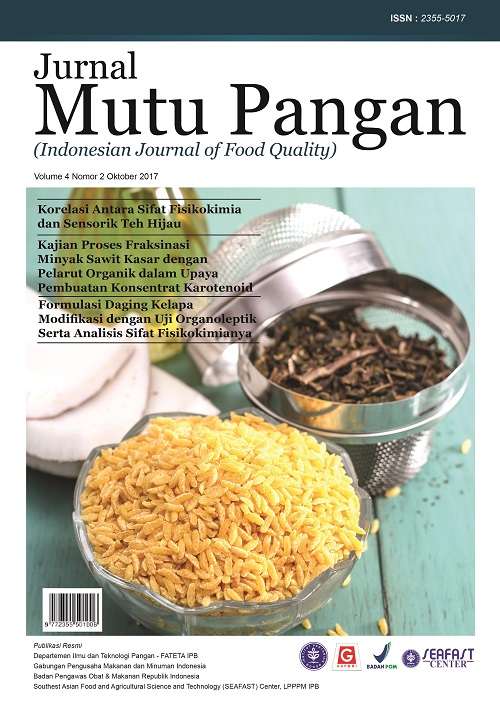Formulasi Daging Kelapa Modifikasi dengan Uji Organoleptik serta Analisis Sifat Fisikokimianya
Abstract
Coconut (Cocos nucifera L.) is a multipurpose plant, either for food or non-food purposes. Coconut meat texture was various, depending on the age of coconuts. This was an obstacle in the coconut beverage industry for using natural coconut meat. The purpose of this study was to create an acceptable modified coconut meat formula, with physical characteristic in accordance with the real coconut meat. The modified coconut meat consisted of real coconut meat, coconut milk, water, and agar which percentages are 71.30, 16.13, 12.10, and 0.26%, respectively. The percentages of carrageenan and konjac for each formula was F1 (0.00:0.23), F2 (0.23:0.00), F3 (0.03:0.20), F4 (0.20:0.03), F5 (0.10:0.13). To find the most preferable formula, a hedonic test was done with tested parameters as follow: taste, aroma, texture, visual appearance and overall. F5 formula was the most preferable formula. Physical analysis of F5 with texture analyzer produces a hardness value of 240.50 gf which is significantly different from real coconut meat control (p≤0.05), ie 325.80 gf. While the value of F5 gel compactness was not significantly different from control (p≤0.05) indicated by the area of F5 (705.73 gs) and control (695.80 gs). Analysis of whiteness with chromameter showed that all samples were not significantly different (p≤0.05) as compared to the control. Result of gel stability observation showed that chart of F5 formula was tend to descend upon time (50.34 to 45.75 g), while the chart of control was ascend at start, but tend to stable upon time (50.78 to 59.24 g). The result of proximate analysis showed that, F5 has 92.06±0.06% water content, 0.25±0.00% ash content, 2.54±0.52% fat content, 0.37±0.0% protein content, 0.17±0.02% crude fiber content, and 4.62±0.56% carbohydrate content.
Downloads
References
Andarwulan NF, Kusnandar, Herawati D. 2011. Analisis Pangan. Dian Rakyat, Jakarta.
[AOAC] Association of Official Analytical Chemistry. 2005. Official Method of Analysis. Association of Official Analytical Chemistry.
[Deptan] Kementerian Pertanian. 2008. Mangga gedong dan kesehatan. Balai Penelitian Buah Tropika, Solok.
[DKBM] Daftar Komposisi Bahan Makanan. 2007. Pusat Penelitian dan Pengembangan Gizi dan Makanan, Departemen Kesehatan.
Haryza Y, Hastuti RB. 2009. Kapasitas penyerapan dan penyimpanan air pada berbagai ukuran potongan rumput laut Sargassum sp. sebagai bahan pupuk organik. J Anatomi Fisiologi 17(1).
Imeson AP. 2000. Carragenan. Phillips GO, Williams PA, editor. Handbook of Hydrocolloids. CRC Press, Boca Raton.
Leo M, Nollet L. 2007. Handbook of Meat Poultry and Seafood Quality. Blackwell Publishing John Wiley & Sons Inc.
Penroj P. 2005. Gelation Mechanism of Konjac Glucomannan/Kappa-Carrageenan and Utilization in Kamaboko. Ph.D. [Disertasi]. Bangkok: Kasetsart University.
Penroj P, Mitchell JR, Hill SE, Ganjanagunchorn W. 2005. Effect of konjac glucomannan deacetylation on the properties of gels formed from mixtures of kappa carrageenan and konjac glucomannan. Carbohyd Polym 59(3): 367-376. DOI: 10.1016/j.carbpol.2004.10.007
Saha D, Bhattacharya S. 2010. Hydrocolloids as thickening and gelling agents in food: a critical review. J Food Sci Technol 47(6): 587–597. DOI: 10.1007/s13197-010-0162-6.
Sinurat E, Murdinah, Bandol UBS. 2006. Sifat fungsional formula kappa dan iota karaginan dengan gum. J Pascapanen Bioteknol Kelautan Perikanan 1(1): 1.

















